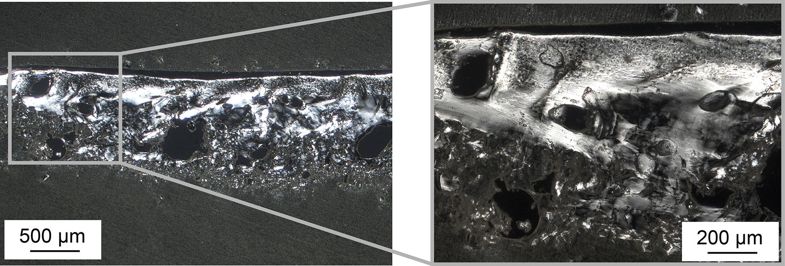Selective laser sintering, or SLS, is a popular 3D printing process for good reason. It has a number of benefits: parts can be produced with virtually unlimited geometry, and supports are not required. It also produces parts that are typically more durable and functional than those produced by other methods of 3D printing. It does have some restrictions in terms of the materials that can be processed, however, and so the resulting component properties are limited. In a paper entitled “Infiltration Behavior of Thermosets for Use in a Combined Selective Laser Sintering Process of Polymers,” a pair of researchers discusses the development of a new additive manufacturing process that combines reactive liquids such as thermoset resins to generate multi-material SLS parts.
 As reactive liquid, two epoxy resins – Araldite GY 764, based on bisphenol A, and Araldite GY 793, based on bisphenol A/F – were used. The surface tension and viscosity of the resins was tested. In addition to the influence of temperature, the influence of the bulk density on the infiltration behavior was investigated. To analyze the infiltration behavior, a resin drop was applied on the powder bed surface with a microliter syringe. The drop was illuminated from one side by a light source and observed by a CCD camera system from the other side.
As reactive liquid, two epoxy resins – Araldite GY 764, based on bisphenol A, and Araldite GY 793, based on bisphenol A/F – were used. The surface tension and viscosity of the resins was tested. In addition to the influence of temperature, the influence of the bulk density on the infiltration behavior was investigated. To analyze the infiltration behavior, a resin drop was applied on the powder bed surface with a microliter syringe. The drop was illuminated from one side by a light source and observed by a CCD camera system from the other side.
The Araldite GY 764 resin showed a higher surface tension than the Araldite GY 793.
“With increasing temperature, the viscosity shows a first decrease, which can be linked to the higher mobility of chain segments with rising temperature,” the researchers state. “For higher temperatures, the crosslinking or rather curing process takes place and the viscosity rises. The minimum viscosity is reached in a temperature interval between 100°C and 120°C for both resin and hardener mixtures. The curing reaction starts for a heating rate of 2 K/min at a temperature of 100°C. This value depends on time and temperature, and thus the heating rate plays a major role. Comparing the two resins, the curing behaves almost equally. The system with the trademark Araldite GY793 shows a slight delay in the viscosity increase.”
As the temperature increased, the infiltration process was accelerated for both resins, and the viscosity was reduced.
“At 20°C, the resin does not totally infiltrate the powder bed,” the researchers conclude. “For the highest analyzed temperature of 60°C, the infiltration takes < 2 s. This means for layer times in selective laser sintering of 40 s and processing temperature of the powder bed surface of 120°C, the infiltration process will not determine the processing time. Thus, the analyzed systems can be used in the combined laser sintering process. Nevertheless, the infiltration depth and parallel curing must be analyzed in further investigations. Furthermore, the Washburn equation was used to predict the infiltration behavior of the used combination of powders and liquids. Taking the simplifications into account, good agreement of the calculated and measured values could be shown.”
The implementation of reactive liquids such as epoxy resin, according to the researchers, in the laser sintering process allows for the generation of multi-material parts, which is why understanding the curing and infiltration behavior of the resins is so important.
Authors of the paper include Katrin Wudy and Dietmar Drummer.
Discuss this and other 3D printing topics at 3DPrintBoard.com or share your thoughts below.
Subscribe to Our Email Newsletter
Stay up-to-date on all the latest news from the 3D printing industry and receive information and offers from third party vendors.
Print Services
Upload your 3D Models and get them printed quickly and efficiently.
You May Also Like
Consolidation in AM: How 2025 Is Shaping the Industry’s New Normal
The first half of 2025 has been marked by a clear shift in the additive manufacturing (AM) industry. Companies are no longer just focused on developing new tech by themselves....
Etsy Design Rule Change Reduces Selection of 3D Printed Goods
Online marketplace Etsy has implemented a rule change requiring all 3D printed goods on the site to be original designs. The update to the site’s Creativity Standards states, ¨Items produced using...
U.S. Congress Calls Out 3D Printing in Proposal for Commercial Reserve Manufacturing Network
Last week, the U.S. House of Representatives’ Appropriations Committee moved the FY 2026 defense bill forward to the House floor. Included in the legislation is a $131 million proposal for...
Transforming From Tourist to Native: Duro CEO Michael Corr Explains Why the Company Rebuilt its PLM Software on AI
In these early innings of the AI boom, many market analysts have expressed concern that AI spend has gotten too far ahead of the technology’s proven ability to deliver significant...


































